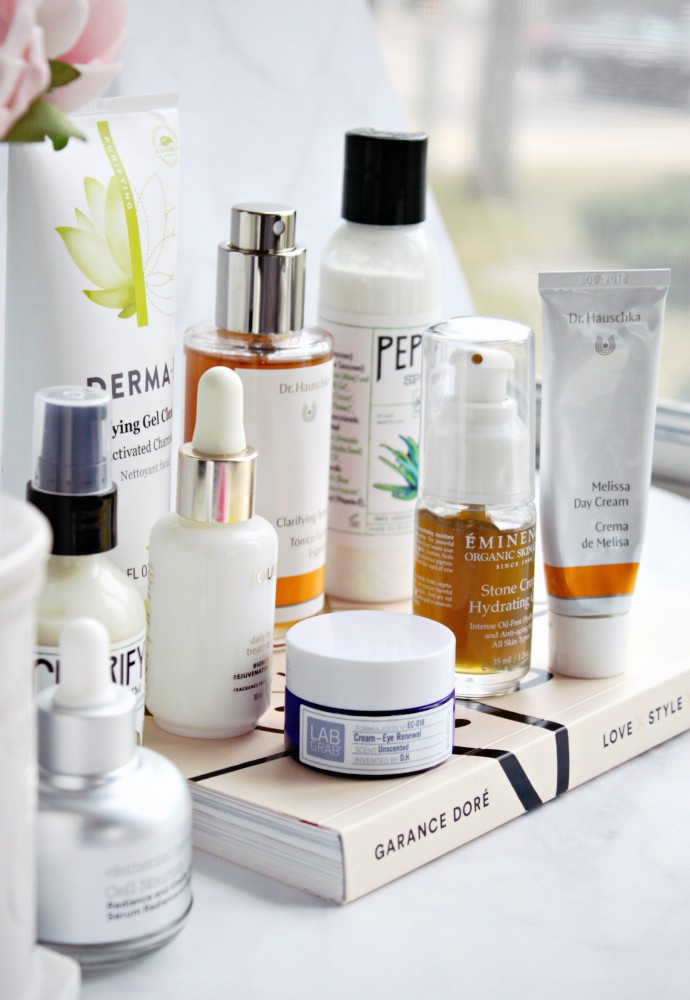
How to Build Clean, Natural & Non-Toxic AM Beauty Routine
It’s been a while since I felt this way. I like to think I am pretty good at determining which skincare products to choose for a complete lineup and how they will work with each other, to some extent. Last week while building my new natural & non-toxic AM beauty routine I sat on the floor, surrounded by stuff, reading ingredients with googly eyes. I felt like a skincare newbie yet again, and it was actually kind of fun.
There are several basic steps every routine should ideally have:
- Cleanse
- Exfoliate
- Hydrate
- Protect in the AM
- Repair in the PM
This is how I break it down for my friends and family who ask for some skincare advice [which, by the way, I am totally not qualified to give], and now it’s time I took it myself, since we’re in uncharted territory here. Or, you know, I could have done the smart thing and checked some blogs that focus on natural and non-toxic beauty, for tips, but what’s the fun in that? 🙂
Today I want to show you the products I used to build my very first natural & non-toxic AM beauty routine. I am pretty new at this, and they may not all be perfect, because I have to make do with what I already have in my stash. Unless you are prepared to spend hundreds [thousands?] of dollars in one go, I think this is the best approach when beginning your transition to natural & non-toxic skincare.

CLEANSE:
I am currently using two products to cleanse and exfoliate my combination/dehydrated skin: a foaming cleanser with tiny exfoliating granules, and a mild astringent toner.
1 // Derma E Purifying Gel Cleanser is currently my cleanser of choice to use in the morning while I shower. This foaming gel looks black straight out of the tube because the formula contains little bits of charcoal, so it also acts as a mild exfoliant. Derma E Purifying Gel Cleanser has pH 5.5 when mixed with my pH 7.0 tap water, so it will not disturb the skin’s protective acid mantle. That’s literally all I ask for in cleansers!
Let’s take a look at the ingredients. According to EWG, the only ingredient I should be wary of is Phenoxyethanol. This is a preservative, used here instead of parabens. Like I said in my Monday post, I am not that concerned about preservatives, but some of you may be, so that is why I will always post color-coded ingredients during my Clean Beauty Month. The rest of the list ranks 1 out of 10 on the toxicity level on EWG, except Glycerin, which is a 2. Overall this cleanser is a great option for a non-toxic beauty routine!
Ingredients: Aloe Barbadensis Leaf Juice, Sodium Methyl Cocoyl Taurate, Glycerin, Sodium Lauroyl Lactylate, Microcrystalline Cellulose, Cellulose Gum, Charcoal Powder, Fucus Vesiculosus (Bladderwrack) Extract, Undaria Pinnatifida (Wakame, Kimarine®) Extract, Epilobium Angustifolium (Canadian Willowherb™) Extract, Organic Camellia Sinensis (Green Tea) Leaf Extract (.1%), Xanthan Gum, Phenoxyethanol, Ethylhexylglycerin.
2 // I use Dr. Hauschka Clarifying Toner immediately after cleansing to prepare my face for the rest of the routine. Ever since I switched to natural and non-toxic skincare, I feel like my pores have been producing more sebum, so I had to add an astringent. Normally, I would skip a product that contains Alcohol as one of the first ingredients, but this was the only non-toxic toner I had in my stash at the time, and my skin actually kind of likes it. I only apply it to areas prone to breakouts, like my nose, chin, and forehead, and it definitely makes my pores look and feel tighter. Note: Because of the amount of Ahcohol it contains, I wouldn’t recommend this toner for people with sensitive skin, nor would I personally use it if my skin ever felt sensitized.
We’ve got some awesome extracts at the top of the ingredient list, which is good, plus exfoliating Lactic Acid and some potentially irritating natural fragrance compounds at the bottom. In high doses they can cause allergic reactions, so if you have allergies to natural oils, you might want to skip this toner. That’s really the only bad part about natural skincare – a lot more people have allergies to plant extracts, nut oils, and essential oils, than they do to synthetic molecules found in conventional skincare. That is why all-natural skincare is not always the best choice, and you have to go by your own individual sensitivities to determine what’s best for you.
Ingredients: Water (Aqua), Alcohol, Anthyllis Vulneraria Extract, Calendula Officinalis Flower Extract, Tropaeolum Majus Flower/Leaf/Stem Extract, Aesculus Hippocastanum (Horse Chestnut) Bark Extract, Echinacea Pallida Extract, Hamamelis Virginiana (Witch Hazel) Bark/Leaf Extract, Bellis Perennis (Daisy) Flower Extract, Natural Fragrance, Citronellol, Geraniol, Linalool, Lactic Acid.
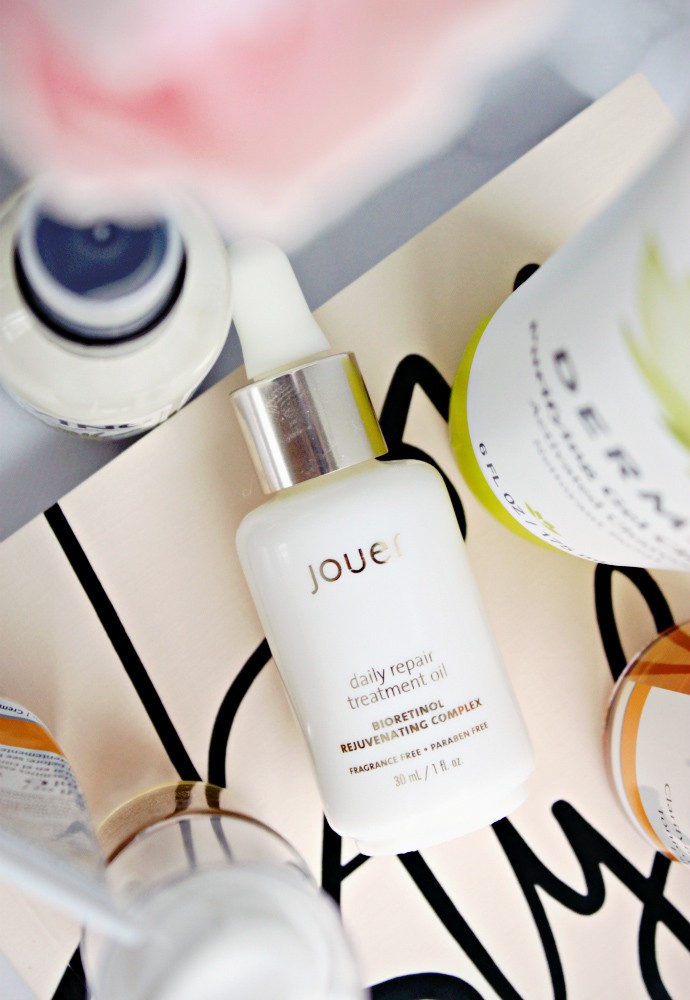
HYDRATE:
For me, hydrating the skin is always a multi-step process. I immensely enjoy layering serums, essences, and creams to achieve the coveted healthy glow, but I had to put away most of my old ones in lieu of options that EWG considers “safe”. Thankfully, the weather is getting warmer, and the humidity is rising, so I don’t need to layer as many moisturizing products as I did in the winter.
3 // Like I said earlier, my skin’s been more problematic than usual, so I am using Erin’s Faces Clarifying Serum to rebalance the oil production. This milky serum is an absolute treat to apply! It contains a combination of anti-aging and astringent ingredients that don’t feel too heavy. It’s the perfect daytime serum that combats both acne and skin aging. You will be hard pressed to find a similar product, because they like a needle in a haystack – incredibly hard to find, and even harder to discover a truly effective one.
EWG gives DMAE a 4 out of 10 hazard rating, based on inconclusive toxicity results unrelated to its use in cosmetics. This ingredient is said to be good for for firming the skin and giving it a more lifted appearance, and derma e actually uses it as a star ingredient for one of their lines [who else tried their DMAE eye cream? I loved it!]. An alternative cosmetic safety measuring app – Think Dirty – inspected this product manually and gave Erin’s Faces Clarifying Serum rating of 0, meaning it is not expected to be harmful in any way when applied topically.
Ingredients: Aloe Barbadensis (Organic Aloe) Juice, Dimethylaminoethanol (DMAE), Simmondsia Chinensis (Organic Jojoba) Oil, Aspalathus Linearis (Organic Rooibos Tea) Extract, Emulsifying Wax, Camellia Sinensis (Organic Green Tea) Extract, Vegetable Glycerin, Camellia Sinensis (Organic White Tea) Extract, Tocopherol (Vitamin E), Sodium Hyaluronate (Hyaluronic Acid), Niacinamide (Vitamin B3), Methylsulfonylmethane (MSM), Salix Nigra (Black Willowbark) Extract, Xanthan Gum (Polysaccharide Gum), Tea Tree Essential Oil, Lavender Essential Oil, Roman Chamomille Essential Oil, German Chamomile Essential Oil.
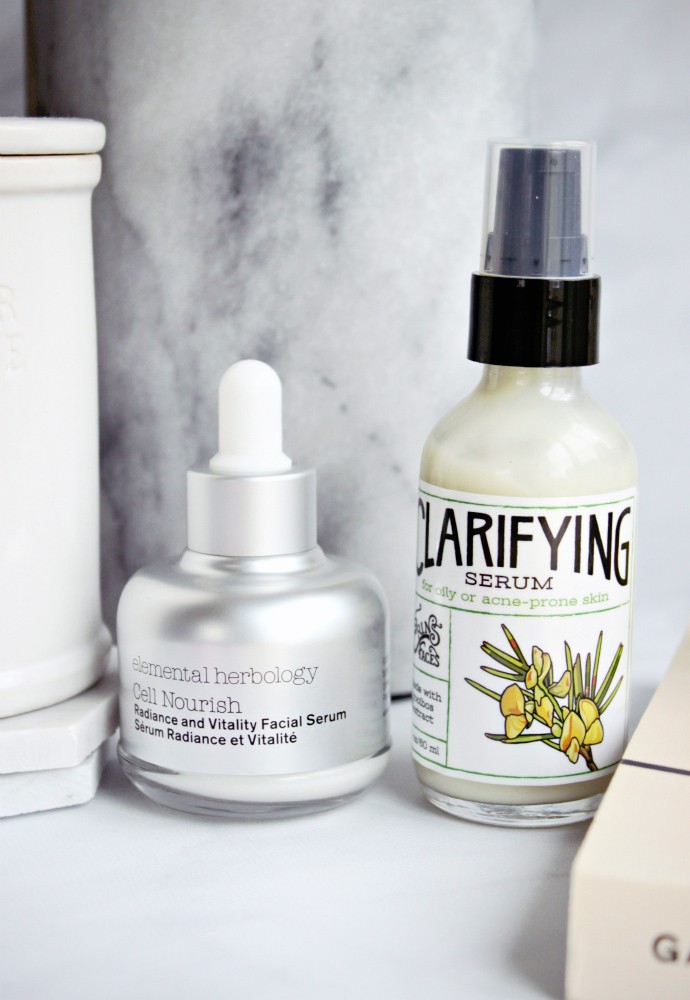
4 // I reviewed Elemental Herbology Cell Nourish previously, so I will just remind you that it’s basically like a supplement for the skin. It’s helpful when you already have all of your anti-aging bases covered, so it works as an antioxidant booster that makes the rest of your routine more effective. It also gives the skin a beautiful glow!
The ingredient list is quite long for a natural beauty product, so I expected there to be a few potential triggers. Even though I am seeing a few reds and several yellow names, when I dissected each ingredient, it wasn’t so bad. Starting at the bottom, those last few ingredients are fragrance notes derived from essential oils, and since essential oils are sensitizing by nature, it means their fragrant heart can be sensitizing as well, especially if used in wrong quantities. To me these are of low concern. Sorbic acid, Potassium sorbate, Benzoic acid, and Phenoxyethanol are preservatives that protect delicate botanical extracts, and all of them are commonly used as alternatives for parabens. When used in low concentration, I believe they pose no risk for health, but to each their own. Some people take green beauty extremely seriously and do not tolerate any potential irritants.
To me, the only questionable ingredient is Retinyl Palmitate, which is a combination of pure retinol and palmitic acid, that works as an antioxidant when applied to the skin. All forms of Vitamin A cause photosensitivity, so I am always cautious about using it during the daytime. This is a controversial ingredient that makes people nervous [I used to avoid products with it, but now I don’t], but recently Paula’s Choice posted an updated review, debunking some of the myths. You can read it here. Based on what I know so far, I will not specifically seek out Retinyl Palmitate, but I won’t shun products with it either, if the rest of the ingredient list looks alright.
This leaves us with Ceteareth-6 Olivate, a penetration enhancer that helps other ingredients absorb better, but may be potentially contaminated with 1,4 dioxane and ethylene oxide, if not purified correctly. This comes down to how much do you trust the brand to source pure and premium ingredients, and I personally trust Elemental Herbology.
Ingredients: Rosa Damascena Flower Water, Aqua, Glycerin, Ceteareth-6 Olivate, Squalane, Punica Granatum Oil, Saccharomyces/Xylinium Black Tea Ferment, Hydrolyzed Soy Protein, Citrus Nobilis (Mandarin Orange) Peel Oil, Camellia Sinensis Leaf Extract, Lecithin, Tocopheryl Acetate, Magnesium Ascorbyl Phosphate, Retinyl Palmitate, Chondrus Crispus (Carrageenan), Pelargonium Graveolens Flower Oil, Ubiquinone, Aloe Barbadensis Leaf Juice, Hydroxyethylcellulose, C12-15 Alkyl Benzoate, Disodium EDTA, Ethylhexylglycerin, Phenoxyethanol, Inulin Lauryl Carbamate, Xanthan Gum, Alcohol, Potassium Sorbate, Sorbic Acid, Dehydroacetic Acid, Benzoic Acid, Polyaminopropyl Biguanide, Citral, Citronellol, Geraniol, Limonene, Linalool.
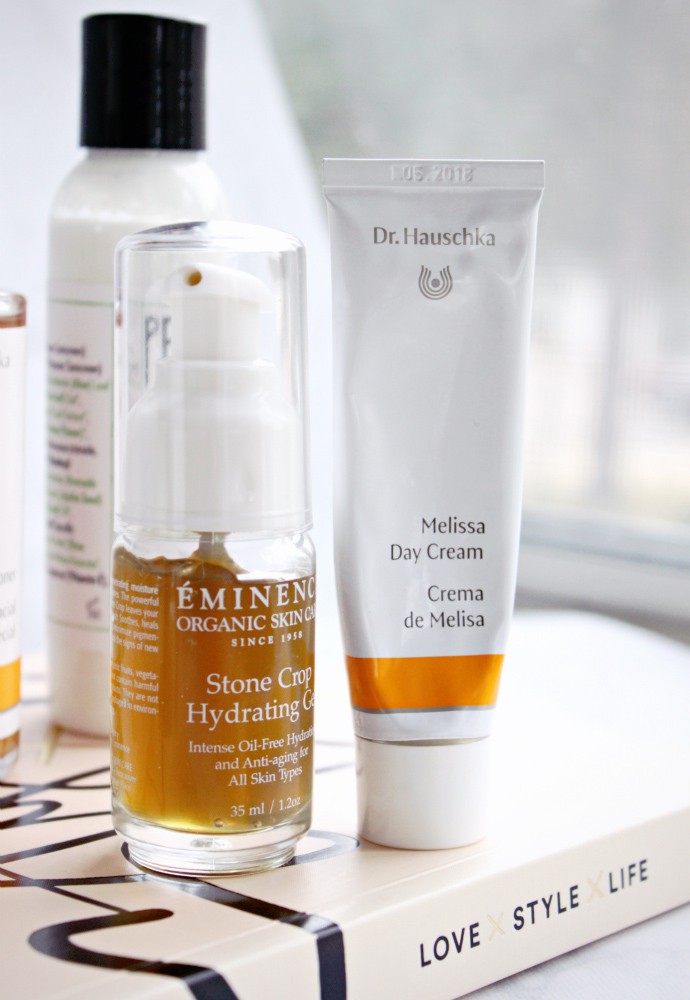
I use a variety of moisturizers, sometimes it’s an oil, other times it’s a cream, and when my face is feeling congested, I opt in for lightweight gel. Keep in mind, I don’t use all of them at once. I normally wear either the Dr. Hauschka or Eminence, and maybe a couple drops of Jouer oil underneath, depending on whether I used a drying peel that day or not.
5 // I love using Jouer Daily Repair Treatment Oil after I had just exfoliated, because it adds the essential fatty oils back to my skin. Plus, it provides a dose of nourishment, loads of antioxidants, and makes my face and neck feel incredibly soft and silky. I bought this one ages ago and still have about half a bottle left. Surprised it didn’t turn rancid on me yet, haha! 🙂
The ingredients are all green and clean.
Ingredients: Helainthus Annuus (Sunflower) Seed Oil, Simmondsia Chinensis (Jojoba) Seed Oil, Bidens Pilosa Extract, Borago Officinalis Seed Oil, Crambe Abyssinica Seed Oil, Elaeis Guineensis (Palm) Oil, Gossypium Herbaceum (Cotton) Seed Oil, Hippophae Rhamnoides Oil, Limnanthes Alba (Meadowfoam) Seed Oil, Linum Usitatissimum (Linseed) Seed Oil, Oryza Sativa (Rice) Bran Oil, Rosa Canina Seed Extract, Rosamarinus Officinalis (Rosemary) Leaf Oil, Salvia Hispanica Seed Oil, Tocopherol.
6 // On most days I just like to wear a thin layer of Dr. Hauschka Melissa Day Cream, a 100% natural moisturizer I talked about in my Winter Skincare Wardrobe post a few months ago. This is easily of the best moisturizers for combination/dehydrated skin I’ve ever tried. It hydrates the skin just enough so it’s plump and healthy, but not greasy-looking, and it helps rebalance oil production, so my pores don’t go out of control even in humid weather. As you can see, the tube looks a lot thinner now, because I’ve been using it religiously. The cream has a faint bitter citrusy fragrance, typical for melissa plant, and for me it’s also an aromatherapy experience because I adore this scent!
As far as the ingredient breakdown goes, you know the drill. The yellows and reds at the bottom are natural fragrances derived from essential oils, that may be sensitizing for some people. The rest of the ingredients have safety levels 1 and 2 out of 10 on EWG, so they are all in the clear as far as I’m concerned. The formula also contains Alcohol, but even though my skin is normally sensitive to it, I couldn’t tell its presence and never felt the tingling associated with it.
Ingredients: Water (Aqua), Helianthus Annuus (Sunflower) Seed Oil, Alcohol, Glycerin, Manihot Utilissima (Tapioca) Starch, Cocos Nucifera (Coconut) Oil, Glyceryl Stearate Citrate, Melissa Officinalis Flower/Leaf/Stem Extract, Arachis Hypogaea (Peanut) Oil, Simmondsia Chinensis (Jojoba) Seed Oil, Prunus Armeniaca (Apricot) Kernel Oil, Anthyllis Vulneraria Extract, Bellis Perennis (Daisy) Flower Extract, Tropaeolum Majus Flower/Leaf/Stem Extract, Hamamelis Virginiana (Witch Hazel) Bark/Leaf Extract, Cetearyl Alcohol, Triticum Vulgare (Wheat) Bran Extract, Daucus Carota Sativa (Carrot) Root Extract, Natural Fragrance, Citral, Limonene, Geraniol, Citronellol, Linalool, Hectorite, Lysolecithin, Xanthan Gum, Coco-Glucoside, Zinc Oxide (CI 77947).
7 // Eminence Stone Crop Hydrating Gel is new on my bathroom shelf, and I’ve only been using it for 3 weeks, but I like it so far. This is the perfect oil-free moisturizer for those of us with combination and oily skin. I will probably wear it throughout the summer, if it even lasts that long. I love that it comes in a gel form, it’s very refreshing and provides an instant boost of hydration when I apply it in the morning. The gel-turns-liquid formula absorbs almost immediately, without leaving my skin feeling tight and dry. It kind of makes my skin feel matte, but supple and bouncy at the same time, if that makes sense. I doubt it has anti-aging properties, but it may be a great pick to quickly hydrate the skin and protect it from free radicals. I love to double- and triple- up on my antioxidants, so the thinner the layers, the better.
There is one red flag in this formula, and it’s Vitamin A. Vitamin A is a blanket term for all retinoids, and some of them are indeed more irritating than others. More likely than not, this product contains a plant-based carotenoid [since this is advertised as a plant-based formula], and the EWG-assigned toxicity for carotenoids is 1 out of 10, which makes it all-green.
Ingredients [taken from the product packaging, as it’s different on the website]: Stonecrop Pulp, Stonecrop Juice, Bearberry Extract, Green Tea Extract, Vegetable Glycerin, Natural Moisturizing Factor, Lavandula Angustifolia Extract, Glycine Derivative (Sorbitol), Xanthan Gum, Biocomplex (Vitamin A, Vitamin C Ester, Vitamin E, Coenzyme Q10, Alpha Lipoic Acid), Lavandula Angustifolia Oil, Chlorophyll.
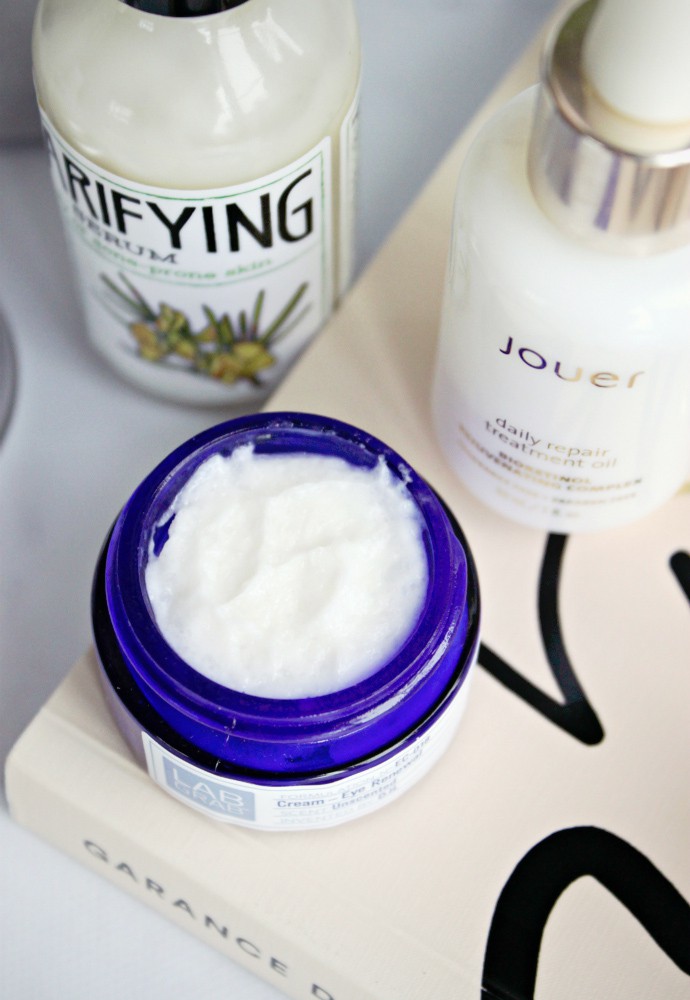
8 // Eye cream for me is essential for many reasons. For starters, the skin around my eyes is very different than the rest of my face: it’s drier, thinner, and I am actually developing lines there. For those reasons I can not use my facial moisturizer as an eye cream, because it won’t address those concerns. But if you are already using a gentle hydrating cream that is safe for applying in the eye area, I don’t see why you’d need an additional product, unless there are concerns your moisturizer can’t address. Right now I am using LabGrab by Silk Therapeutics Cream-Eye Renewal Formulation No. EC-018, a limited edition release made with the purest form of silk available, and a very minimal number of highly potent natural ingredients added. It’s highly concentrated, so a little goes a long way. It makes the eye area feel tighter and helps reduce morning puffiness.
Ingredient list is as pure as it gets, plus, Silk Therapeutics products are EWG-certified, which means they voluntarily subjected their formulations to scrutiny and passed the test with flying colors. Now they have a nice green EWG-verified badge next to their name, which very few products do. I wrote a blog post about Silk Therapeutics, and specifically their LabGrab project, you can check it out here if you want. It’s truly a unique company, unlike any other, that many of you would be interested to learn more about.
Ingredients: Water, Rosa Moschata (Rosehip) Seed Oil, Soluble Fibroin (Silk), Caffeine, Citric Acid, Sodium Anisate, Populus Tremuloides Bark Extract (Aspen) Bark Extract.
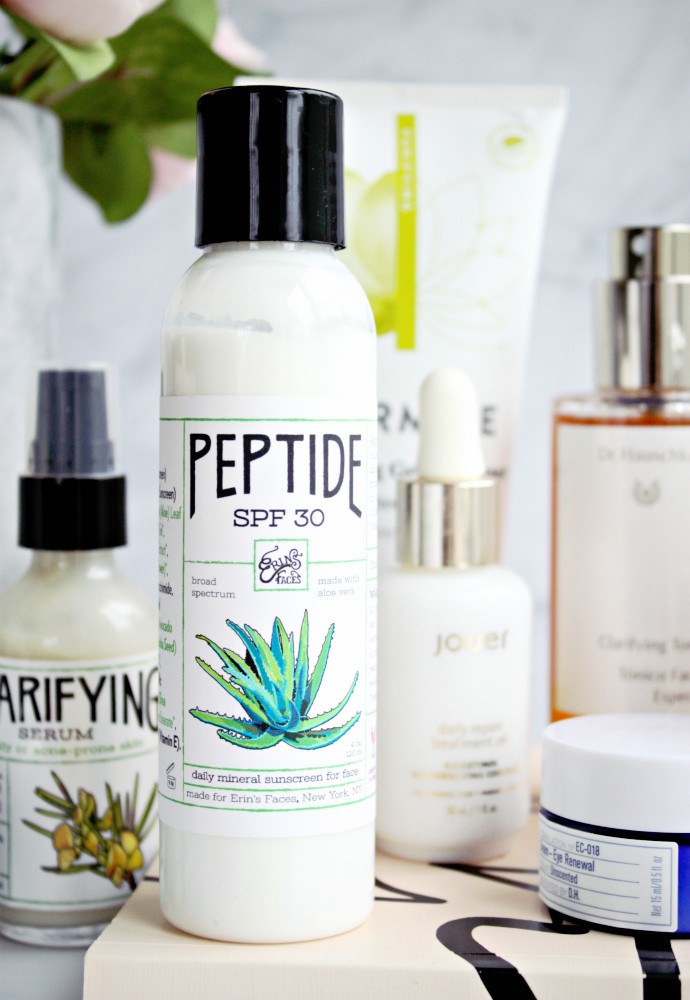
PROTECT:
9 // Sun protection for me is a non-negotiable step, so when building my natural & non-toxic AM beauty routine, I searched for healthier sunblock options with cleaner ingredients. Truth be told, I was happy with the sunscreens I was using, but some formulas are definitely dirtier than others, according to EWG, Think Dirty, and other cosmetics evaluation resources. Erin’s Faces Peptide SPF30 UVA/UVB physical sunblock provides moderate broad-spectrum protection, perfect for everyday wear. I use it on cloudy days and also when I work from home, because my desk is located right next to a huge sliding door that lets a lot of sunlight through. What I love most about this sunscreen is the texture. It feels like a normal moisturizer rather than a thick sunblock: it’s slightly runny, easily spreads on the skin, doesn’t make my face look white, and doesn’t pill if I apply makeup on top.
All of the ingredients pass the general safety test, according to EWG and CosDNA databases. Think Dirty inspected this product and gave it 1 out of 10 toxicity level. Talk about clean sunscreen, am I right?
Ingredients: Titanium Dioxide 5%, Non-Nano Zinc Oxide 5%, Organic Aloe Barbadensis (Aloe Vera) Leaf Juice, Aloe Barbadensis (Aloe Leaf) Gel, Vegetable Glycerine, Cucumis Sativus (Cucumber) Fruit Extract, Passiflora Caerulea (Blue Passion Flower), Palmitoyl Oligopeptide (Matrixyl 3000), Hydroxysuccinimide, Palmitoyl Tetrapeptide-3 (Matrixyl 3000), Palmitoyl Pentapeptide-3 (Matrixyl), Persea Gratissima (Avocado Seed) Oil, Simmondsia Chinesis (Jojoba Seed) Oil, Vittis Vinefera (Grape Seed) Oil, Vegetable Glycerine, Capric/Capryllic Triglycerides, Butyrospermum Parkii (Shea Butter), Stearic Acid (Vegan), Glyceryl MonoStearate, Cyclomethicone (Silica), Tocopheryl (Vitamin E), Cetyl Alcohol, Mica.
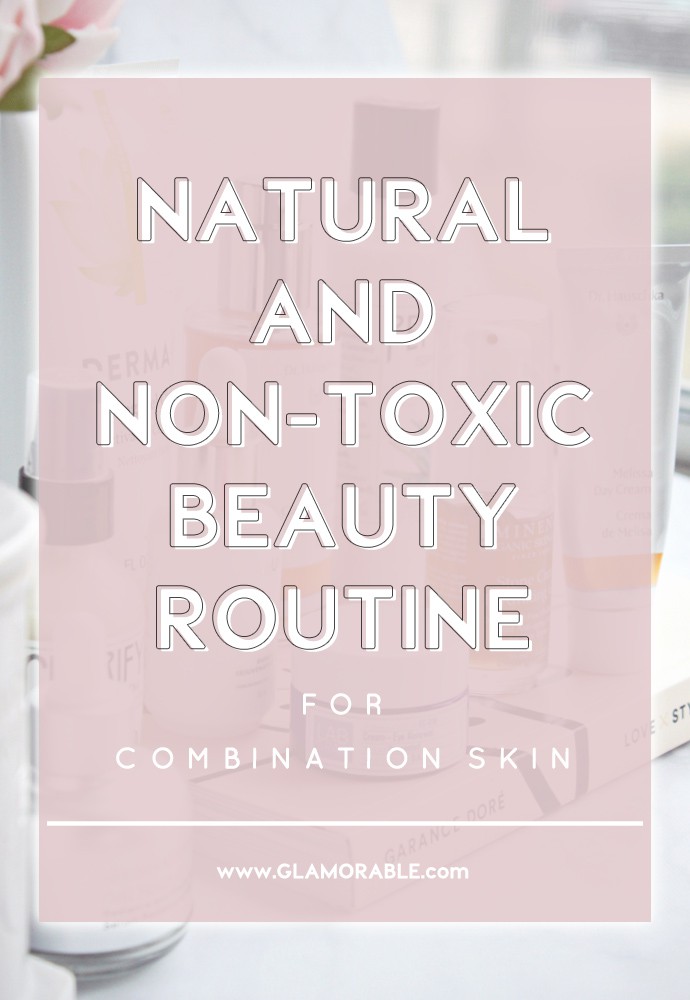
What do you think of my first attempt at building natural & non-toxic beauty routine? I managed to find some pretty amazing products, and it was fun to share my discoveries with you. I was being very descriptive just so you guys understand where I stand when it comes to different ingredients and what my overall thoughts are on clean skincare. I found myself to be quite lenient about several controversial
In the end I learned a couple things:
- Clean and/or all-natural beauty products are definitely not boring. I imagined them to have the sophistication level of Pinterest DIYs, but there are some pretty darn clever formulas out there that go beyond “mix almond oil with shea butter” [not that there’s anything wrong with that].
- Cross-referencing different ingredient analysis websites instead of relying on just one is time-consuming, but it’s the way to go, because all of them don’t have the same database and they cite different sources, some newer than others. It’s helpful to gain perspective, especially about controversial ingredients.
- Everybody has their own definition of green and clean. I am perfectly fine with the products above, as they are a lot cleaner [by EWG standards] than what I used before. However, I just can’t see myself using nothing but shea butter and coconut oil, so it’s unlikely that my routine will ever be made of 100% EWG-approved skincare. After all, some of the best and most effective anti-aging molecules are either lab-made or sensitizing [duh, acids!].
- 100% clean beauty is great for overall skin health, but not so much for anti-aging. If anti-aging wasn’t my concern, then maybe I wouldn’t care as much, but as it stands, I already began missing my favorite actives from The Ordinary, and strong acid peels.
I’ll be back with my PM routine list soon! Hopefully it won’t be another wall of text, like this post turned out to be, haha.
Would you switch your routine to natural and non-toxic? Have you ever tried going green and/or clean? Let me know in the comments!
Disclosure: This post features PR samples and products purchased by Glamorable, and may contain affiliate or referral links. For more details about my product review policy, copyright, and information about affiliate links, please refer to Disclosures & Content Use page.


